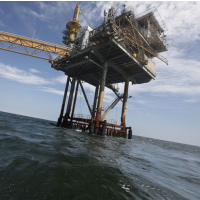Federal Court Orders Interior Dept. to Reveal Details of Fracking in Gulf of Mexico
 (photo: Gerald Herbert, AP)
(photo: Gerald Herbert, AP)
The Department of the Interior has been ordered by a federal judge to turn over
documents revealing how much fracking has been going on in the Gulf of Mexico.
The Center for Biological Diversity has tried for eight months to obtain records on fracking wells in the Gulf, only to have its Freedom of Information Act request rejected. So the environmental group sued the Interior Department, which lost the case. Two federal offices that regulate offshore oil and gas production now must release the fracking documents beginning in July. They will have nine months to comply with the court order.
“The thing that I find shocking is that, this is the agency that’s supposed to be regulating offshore drilling, and they don't keep track of it nor have a system that is amenable to searching for it,” plaintiff attorney Miyoko Sakashita told Truthout.
Information about onshore fracking is readily accessible, but data on offshore fracking isn’t made available to the public on government and industry tracking databases.
“Offshore fracking has been shrouded in secrecy, but this settlement will finally force the government to tell us where oil companies are using this toxic technique,” Kristen Monsell, another plaintiff lawyer, told Truthout. “Fracking pollution is a huge threat to marine animals, and the high pressures used to frack offshore wells increase the risk of another devastating oil spill.”
Last year, the government released a partial list of fracking wells in the Gulf that showed there were 115 platforms that, as of 2013, used an unconventional technology known as “frack packing”. The technique is a safety measure designed to protect well production equipment by limiting the amount of sand generated in the process.
The center contends that the total number of wells may far exceed 115, considering there are 4,000 oil and gas platforms in Gulf waters and the oil industry has indicated the technique is being used in that area to exploit untapped reserves.
“The seafloor of the Gulf of Mexico is not flat; it is full of canyons and ridges and steep inclines and declines,” Gulf Restoration Network’s Jonathan Henderson told Truthout. “There's faults; it's unstable, and any activity that industry engages in on the seafloor, it can have effects that could be catastrophic.”
-Noel Brinkerhoff, Danny Biederman
To Learn More:
US Interior Department Compelled to Reveal Extent of Fracking in Gulf of Mexico (by Mike Ludwig, Truthout)
What Is the Government Not Telling Us About Fracking in the Gulf of Mexico? (by Mike Ludwig, Truthout)
Extent of Stealth Fracking in Gulf of Mexico Revealed (by Paul Abowd, Al Jazeera America)
- Top Stories
- Unusual News
- Where is the Money Going?
- Controversies
- U.S. and the World
- Appointments and Resignations
- Latest News
- Trump to Stop Deportations If…
- Trump Denounces World Series
- What If China Invaded the United States?
- Donald Trump Has a Mental Health Problem and It Has a Name
- Trump Goes on Renaming Frenzy






Comments